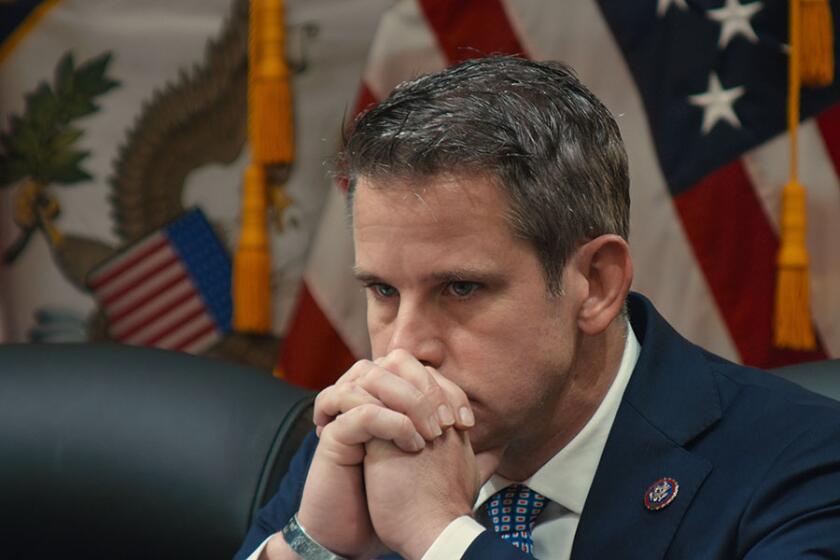San Gabriel Valley Is the Shooting Star of Film Locations
Mary Ann Otero’s home is 97 years old, but it’s the last seven years that have been the most exciting.
The turn-of-the-century Victorian has been invaded by “Twilight Zone” parakeets, commandeered by weekend fishermen, overwhelmed by women with laundry bleach and overrun by starving sheep dogs.
In short, thanks to the magic of Hollywood, Otero’s house has become just about anything a commercial, TV or film director wants it to be. Since 1983, her family has played host to 29 film projects.
But Otero’s is not the only area site that serves filmmakers looking for the ultimate in middle-class or small-town Americana.
The San Gabriel Valley--with its restored Victorian houses, quaint business districts and California bungalows--has become an extension of Hollywood’s back lot.
For example, if you think that Hope and Michael’s house on television’s “thirtysomething” is in a yuppie suburb of Philadelphia, think again. It’s actually located on a quiet street in South Pasadena.
And the biker hangout where Cher lived with her son in the movie “Mask”? That was on Canyon Drive in Monrovia.
“It has the look of Anytown, U.S.A.,” said Linda Proctor, whose Monrovia-based company, Oh, Shoot!, coordinates filming in the San Gabriel Valley. “You can find almost any kind of home here, and there aren’t palm trees lining every street.”
Proctor, 49, who runs her business out of her home, keeps busy smoothing the way for filmmakers who need to obtain city permits, Fire Department approval and sometimes street closures to do their work. Proctor, who has arranged a number of shoots at Otero’s house, started her business as a casual effort in 1986 and went full time last year.
Her duties include notifying neighbors when filming is occurring and helping directors and producers find locations. “I’ve been asked to find a knotty-pine kitchen for a John Denver cereal commercial, an old-fashioned basement with doors that open up from the ground and a house with a circle driveway and a bay window on the left,” she said.
Proctor also acts as a go-between for homeowners or business people whose property is being used in a film shoot. “Sometimes a homeowner is not prepared, and then overwhelmed when a crew of 90 shows up,” she said.
Proctor is part of a small cottage industry that has developed along with the San Gabriel Valley’s popularity as a Hollywood location. There are at least two similar businesses operating in Monrovia: The Camera Connection and Perfect Locations. In addition, the California Film Commission lists another such company, called Location Services, in West Covina.
Sandy MacIntosh of Perfect Locations said she launched her business in response to all the requests for scouting help she received from her family’s entertainment industry connections--her husband and son both work in Hollywood.
“I actually got started because I was tired of giving out this information for free,” MacIntosh said.
Proctor said few homeowners refuse a request to have their house used in a movie. At least not the first time.
“Initially, it’s too exciting not to be a part of it,” she said. “The second time around, a homeowner may have thought better of it.”
The money may lure homeowners back for a second go-round, however. Although fees are negotiated individually, Proctor said an average one-day charge for the use of the outside of a house is $500. If the filmmakers use the interior of the house, the fees usually start at $1,000 a day and go up, depending on the extent to which the house is used.
For on-site supervision, Proctor receives 10% of the homeowner’s share. When companies hire her to take care of the red tape, she receives a daily fee.
Sometimes, film crews change the look of a house temporarily, Proctor said. “For a recent Gary Busey movie in Monrovia, they completely took apart the front yard of a house, transplanted the plants, put up a picket fence and put a two-story facade on the neighbor’s house,” she said.
Some cities, like Monrovia, encourage such film projects--for the city permit revenues and for prestige, Proctor said.
And since 1984, the state government has actively encouraged filmmakers to stay in California, instead of looking for out-of-state locations. Following suit, many local cities have reduced their fees for film permits and cut the red tape that goes along with filming.
This month, Monrovia substantially reduced its fees for film permits. City management analyst Isa Kravitz said first-day permits went from $468 to $150 and subsequent-day film permits were reduced from $234 to $75.
Permits, which used to take weeks to process, can now be completed two days before filming if there are no special effects or road closures involved, Kravitz said.
Several other cities--including Pasadena--also have lowered fees in recent years to attract more filming.
“We have four to six productions a week around town,” said Mattie Henderson, Pasadena’s film liaison coordinator.
Janet Jackson and Phil Collins both used a Pasadena city power plant to make music videos recently, Henderson said, and the TV show “Unsolved Mysteries” regularly uses Pasadena’s domed City Hall.
In Sierra Madre, the Alverno Catholic girls’ high school is a favorite location for filming because of a villa on the school grounds. The villa, a 1930s replica of a Tuscany mansion, has marble floors, high ceilings and a classic library.
Best of all, said Principal Elizabeth Broome, there is no family to oust from the premises during filming because the villa serves the school only as a place to hold occasional dances or socials.
The Los Angeles County Arboretum in Arcadia is also popular with filmmakers because it has several restored, vacant houses. The television show “Fantasy Island” was filmed there for many years.
And Monrovia’s homes and restored downtown businesses are the settings for about 30 movies, television shows and commercials every year. Producers especially love downtown Myrtle Avenue because it has slotted--rather than parallel--parking, Kravitz said. Slotted parking looks old-fashioned and makes for good action shooting because actors can park more quickly, Kravitz said.
The filming brings mixed reactions from people who live and work in the San Gabriel Valley.
Bill Moore, advertising director for the South Pasadena Journal, said his weekly newspaper covers much of the filming in town. But he noted: “The people who live here take it totally for granted, honestly.”
For tourists, however, the film boom is a thrill. “I had Midwest visitors who absolutely went out of their minds,” Moore said. “They had never seen a motion picture actor--a live one--before.”
Although cities like Monrovia solicit filming, other cities only tolerate it.
“It disrupts the citizens’ lives quite a bit. We don’t really encourage it,” said Barbara James, director of finance for South Pasadena. “People complain that they can’t park in front of their houses, the crews leave trash lying around, the generators make noise, and they tinker on things at 5 a.m.”
For people like Otero, though, the excitement and glamour of having Hollywood literally in their back yards is worth the trouble.
Otero, who was first contacted by a film location scout shortly after she moved into her home in 1979, published a brochure touting the house’s historical look and sent it to major film studios about five years ago.
“I like the filming going on,” Otero said on a recent Tuesday as an AT&T; commercial was being shot at her home.
“It’s always different. You get to know the people and then they keep coming back,” she said.
Over the years, Otero and her family have watched their kitchen sink turned into a staging ground for everything from Clorox commercials to feature films.
“Sweet Hearts Dance,” a feature film, was made there in 1988. Actor Don Johnson climbed a tree in Otero’s back yard for that film so he could do a scene with a character standing on Otero’s balcony.
“You never know what they’re going to do,” Otero said, recalling the time that the “Twilight Zone” television director let parakeets fly through the house to create a special effect. Dogs have also run down Otero’s halls on their way to brimming bowlfuls of Ken-L Ration.
One of her daughters unexpectedly got a part in an earlier AT&T; commercial that ran on national television for three years and paid off handsomely in residuals, she said.
Otero limits filming at the house to 14 days a year--for tax purposes and for the sake of sparing her neighbors. “They’ve been really good about it,” she said. “Whenever anything is being filmed I get food from the caterers and take it to them. And they’re always invited over to watch what’s going on.”
Proctor said she seldom hears complaints from neighbors. “Some people are certainly inconvenienced by traffic control or lack of parking,” she said. “But on the other hand, their house could be next.”
LOCAL FILMING
Some of the movies and television shows filmed recently in the San Gabriel Valley.
Movies
Back to the Future, I, II and III; Ghost Dad (a new Bill Cosby film, not yet released); Mask; Nightmare on Elm Street 4; Say Anything; Sweet Hearts Dance; 976-EVIL
Television
Columbo; Dallas; Falcon Crest; Mancuso F.B.I.; Matlock; Quantum Leap; thirtysomething; Unsolved Mysteries
Source: City film liaisons
More to Read
Only good movies
Get the Indie Focus newsletter, Mark Olsen's weekly guide to the world of cinema.
You may occasionally receive promotional content from the Los Angeles Times.








